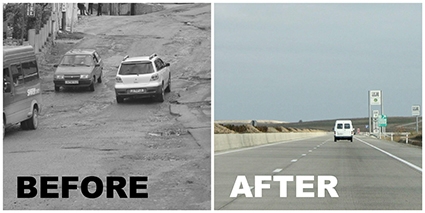The New Silk Road Chain Is Only as Strong as Its Weakest Link
Speaking at the opening of the Tbilisi Silk Road Forum, Georgia’s new Minister of Foreign Affairs Giorgi Kvirikashvili evoked electric circuitry as a metaphor to describe the future or rail and road connections between Europe and Asia. A graduate of the prestigious math and physics Komarov School, Kvirikashvili explained that that a sequential circuit – a simple chain – crucially depends on each and every one of its links. A parallel circuit, on the other hand, allows to redirect electricity flows (or cargo and passengers) through alternative routes.
The vision for the New Silk Road, as expounded by all speakers in the forum, is one of parallel circuitry, creating a healthy competition between alternative providers of transport infrastructure and logistics services along the route. Countries that will do well in this competition, will attract greater volumes of traffic and related investment. Countries that will create bottlenecks along the way, will be bypassed.
Georgia is the first country to host the Silk Road Forum outside China, and for a reason. Georgia’s strategic location, the free trade agreements it possesses with Europe, Turkey and the CIS, as well as its open, safe and corruption-free business environment make it an attractive investment destination for Azeri, Kazakh, or Chinese companies seeking to ship their products to Europe (and vice versa). Yet, to efficiently service increasing volumes of international cargo, Georgia is required to make very significant additional investment in the development (and maintenance) of its transport infrastructure.
THE ROADS WE FIX
Georgia’s East West Highway (EWH) is a small but significant piece of the New Silk Road initiative, which is crucially important not only for other (landlocked) countries in the region, but also for Georgia itself. It connects Georgia’s sea ports and resorts in the west and Georgia’s main population centers, as well as its industry and agriculture in the east. Georgia relies on this road for internal communication, for exports and imports, and for the movement of tourists.
According to a series of World Bank feasibility studies, the first one of which was conducted in 2008, the EWH carries over 60 percent of total foreign trade and is a central piece in the Government’s strategy of transforming Georgia into a transport and logistics hub. It runs from the Red Bridge at the Azerbaijani Border to the Poti Port on the Black Sea coast for around 392 kilometers—about 2% of Georgia’s total road length, and slightly less than a quarter of its international road network. At present, it carries about 7,800 vehicles per day; and this figure grows at about 7% per annum.
A major reconstruction/rehabilitation effort started in 2006, and has remained a top government priority ever since. Yet, only 30% of the road had been thoroughly upgraded thus far. Progress has been slow because this $2.3bn project is primarily financed by loans from international financial institutions and development banks such as ADB, JICA, WB, and EIB. Instead of working in parallel on the entire length of the road, the Georgian government’s preferred approach was to borrow and build sequentially.
While the various feasibility studies estimate the direct economic costs and benefits of this ambitious project, they do not consider the broader social and economic impacts since these are difficult to incorporate in the standard cost-benefit analysis framework. Accomplishing this feat was a task ISET-PI was commissioned to do by the World Bank in 2015.
THE BENEFITS WE REAP
Our estimation focused on the economy-wide effects of investment in EWH. To do so, we constructed a so-called Computable General Equilibrium (CGE) model, which captures the impact of transport on all other sectors of the economy, be it tourism, manufacturing or agriculture.
According to our calculations, once the road is fully upgraded, savings on vehicle operating costs and time during a year would total about $97mln and $194 mln, respectively. These direct benefits alone add up to more than $3.1 bln (at 8% discount rate) or $2.6 bln (at 10% discount rate) over 25 years, which is a reasonable estimate of the new road’s lifespan. In other words, the direct benefits of investment in EWH exceed its cost (about $2.3 bln).
Considering the role of transportation in all other sectors of the Georgian economy, the positive spillover effects of investment in EWH translate into much more significant gains over the medium and long-term. In particular, real GDP is assessed to increase by 1.5% in the medium-term and 4.2% over the long-term horizon, contributing to welfare gains for all household categories. Interestingly, on average, rural households are expected to gain more than urban households.
Note that these benefits are on top of any direct impacts associated with EWH-related construction works, which also contribute to real GDP and employment in the short run. They are also net of many other potential benefits such as decreases in road accidents and environmental impacts. Such gains are likely to be non-trivial as EWH currently accounts for about 43% of all recorded accidents and traffic deaths in Georgia. Thus, what we estimate is the lower bound of the actual benefits due to EWH.
What follows from this analysis is that Georgia has no time to lose in upgrading its road infrastructure. Whatever the costs, they are far-far outweighed by the benefits.
AND THE SNAGS WE (MAY) HIT
While agreeing that the East-West Highway project is likely to be one of the most important infrastructure undertakings in Georgia’s recent history, we should nevertheless be mindful of several serious challenges associated with the project.
Maintenance. For the benefits of an upgraded road network to be sustained, one-time road improvements must be followed by a well-planned road maintenance program. According to WB estimates, running through a mountainous terrain and increasingly used by heavy transit trucks, EWH will require about GEL 16.5mln in additional annual maintenance costs (some of these could be recovered through transit fees levied on trucks). In any case, the government should plan to allocate appropriate resources in its future budgets.
The “Shrosha challenge”. Since many sections of the new EWH are going to bypass existing settlements, the government should urgently consider alternative models to support those communities whose livelihoods currently depended on EWH. The Shrosha community is a good case in point. Located some 40km west of the Likhi mountpass, the entire community is specialized in the production of handmade clay pottery. For nine years since the beginning of road rehabilitation works, the community does not know what will happen to their business and way of life in case the Chumateleti-Argveta section of EWH is rerouted. The lack of communication is causing a lot of frustration and prevents residents from taking investment decision or any other steps to reorganize their business.
Prioritization. There are still quite a number of stretches along the EWH to complete. A thorough analysis should be conducted to establish priorities, but, at least at first sight, the current state of the Tbilisi bypass road appears to justify an early intervention. Damaged by avalanches and not thoroughly repaired since Soviet Union days, this road is rarely (if ever) frequented by government limousines, while serving the entire East-Way cargo traffic.
Alternatives. The parallel electric circuit metaphor applies equally well to the development of national transport infrastructure. While the focus of our study was on Georgia’s EWH, we should not lose sight of alternatives, such as the Georgian Railways. A state-run monopoly, the Georgian Railways is notorious for a lack of efficiency. It is expensive, slow and not sufficiently responsive to business needs. Now, EWH and the Georgian railways are part of a parallel transport circuit. The lack of efficiently on the Georgian railway translates in excessive demand for road transportation, congestion on EWH and, consequently, higher costs for businesses.
The government is now discussing ambitious railway modernization plans, including the construction of new tunnels, etc. This is a great long-term initiative. Yet, significant improvement could be achieved already in the nearest term through changes in the management of Georgian railways. Georgia cannot afford leaving it in the hands of government bureaucrats.
* * *
Investment in transport infrastructure clearly represents the best possible use of Georgian taxpayers’ money. Yet, as often is the case, the devil is in the detail. Failure to tackle these seemingly small issues in a timely manner is likely to backfire, reducing the benefits from an otherwise wonderful undertaking.
Yaroslava Babych, Lasha Labadze, and Eric Livny












